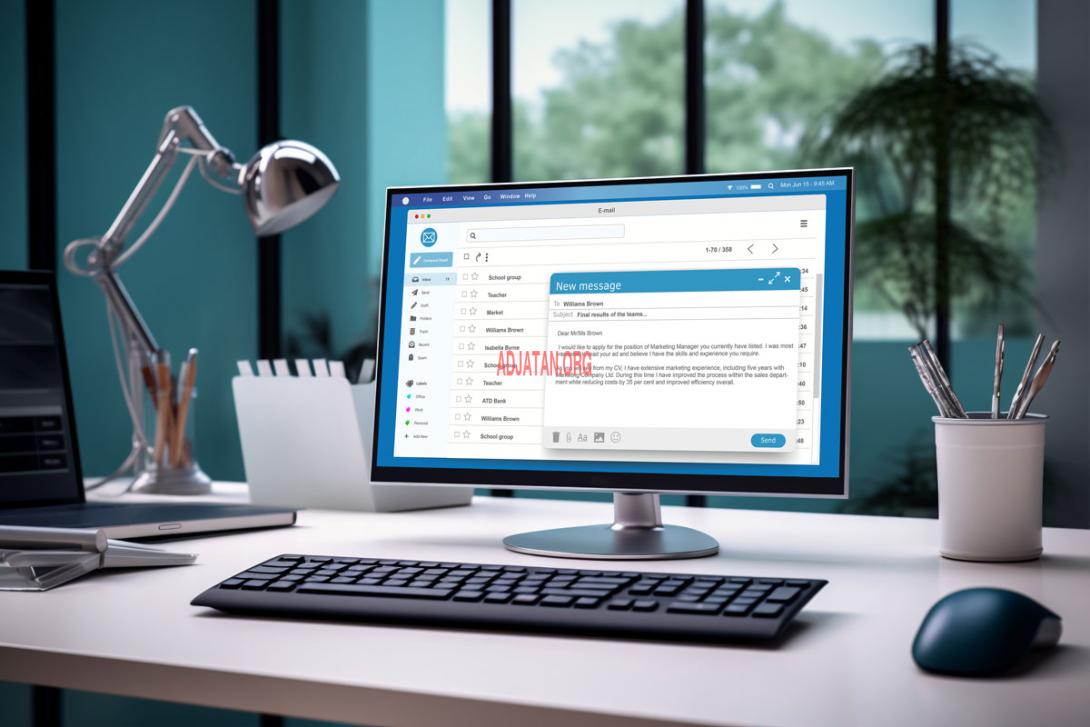
Why Use Outlook for Your Internal Newsletters?
In a business environment, internal communication plays a crucial role in keeping teams informed and engaged. While specialized platforms like Mailchimp, Sendinblue, or Brevo offer advanced features for creating and distributing newsletters, their use may be restricted in many organizations.
Security and Compliance Issues
Many companies, particularly in regulated sectors (finance, healthcare, defense), limit the use of third-party tools for several reasons:
- Protection of sensitive data: Internal distribution lists contain confidential information that should not leave the company's infrastructure.
- Regulatory compliance: Certain regulations (GDPR, HIPAA, SOC 2) impose strict restrictions on sharing data with external platforms.
- IT security policies: IT teams often restrict the installation of software or the use of unapproved cloud services.
- Administrative control: The need to maintain centralized governance of corporate communications.
Advantages of Outlook for Internal Newsletters
Microsoft Outlook, already deployed in most companies, offers several advantages for distributing internal newsletters:
- Direct access to company directories: Immediate use of existing distribution lists and groups.
- Integration with the Microsoft 365 ecosystem: Native compatibility with Word, PowerPoint, and other tools already mastered by teams.
- Security and compliance: Communications remain within the company's approved infrastructure.
- No additional costs: Use of a tool already licensed.
- Familiarity: Interface known to all employees.
Professional Method for Creating and Distributing a Newsletter via Outlook
1. Designing Your Newsletter Content
Several approaches are possible for creating the HTML content of your newsletter:
Using Specialized HTML Editors
- Stripo or Bee Free: These online editors allow you to create HTML templates adapted to emails without technical knowledge.
- MJML: A framework that simplifies the creation of responsive emails by automatically generating HTML code compatible with most email clients.
Leveraging Microsoft Tools
- Word: Create your content in Word and then export it to HTML (File > Save As > Web Page).
- PowerPoint: Design your layout as a slide and then export to HTML.
Other Alternatives
- Canva: Ability to export your designs to HTML via certain premium features.
- Adobe Express: Creation of visuals that can be exported for integration into an HTML template.
2. Importing HTML Code into Outlook
Inserting HTML code into Outlook presents particular challenges, as Microsoft Outlook imposes significant restrictions for security reasons. Here are detailed methods to overcome these obstacles:
Source Code Method (without add-on)
Contrary to what one might think, simply copying and pasting HTML code into the body of the message will not work correctly in Outlook. Here is the complete approach:
- Create a new message in Outlook.
- Go to the "Format Text" tab and check that the HTML format is selected.
- To access the underlying HTML editor, you need to use a special key combination: press Alt+F11 to open the VBA editor.
- In the VBA editor, paste the following code and run it (F5):
Sub InsertHTMLCode()
Dim objItem As Outlook.MailItem
Dim objInsp As Outlook.Inspector
Dim wdDoc As Object
Dim wdRange As Object
Set objItem = Application.ActiveInspector.CurrentItem
Set objInsp = objItem.GetInspector
If objInsp.EditorType = olEditorWord Then
Set wdDoc = objInsp.WordEditor
Set wdRange = wdDoc.Range(0, 0)
' Insert your HTML code here
wdRange.InsertBefore "YOUR_HTML_CODE_HERE"
wdDoc.Save
End If
Set wdRange = Nothing
Set wdDoc = Nothing
Set objInsp = Nothing
Set objItem = Nothing
End Sub
- Replace "YOUR_HTML_CODE_HERE" with your complete HTML code.
- This method bypasses Outlook's usual restrictions by directly accessing the underlying Word editor.
Temporary File Method (more accessible)
If the VBA method seems complex, this approach is more accessible:
- Save your HTML code in an .html file on your computer.
- Open this file directly with your browser to verify that it displays correctly.
- In Outlook, create a new message.
- Click in the body of the message, then drag and drop the HTML file from the file explorer.
- Outlook will offer you several options: choose "Insert as text."
- Caution: this method may sometimes alter the HTML code. If you notice problems, try the next method.
Saved Web Page Method
This method is particularly effective for preserving the integrity of the HTML code:
- Open your HTML code in a browser.
- Make necessary adjustments directly in the browser with the developer tools (F12).
- Once satisfied with the rendering, use the "Select All" function (Ctrl+A) to select all the displayed content.
- Copy this content (Ctrl+C).
- In Outlook, create a new message and paste (Ctrl+V).
- This method works better because it bypasses Outlook's restrictions by copying the interpreted HTML rendering rather than the raw source code.
Solution with Add-on (recommended for regular use)
If you regularly send newsletters and add-ons are allowed in your organization, the most effective solution is to use Insert HTML by Designmodo. This free add-on is specifically designed to solve the problems of inserting HTML code into Outlook.
Insert HTML by Designmodo allows you to easily insert HTML emails into Outlook and send them to your contacts, clients, colleagues, or friends. With this solution, you can use and send pre-designed email templates without any coding or programming knowledge.
To install and use it:
- Go to Microsoft AppSource: https://appsource.microsoft.com/en-us/product/office/wa200002918
- Click "Get it now" to install the add-on in Outlook.
- Once installed, open Outlook and create a new message.
- In the ribbon, you'll see a new "Insert HTML" tab. Click on it.
- An interface will open allowing you to either paste your HTML code directly or import an HTML file.
- Validate, and your HTML newsletter will be correctly integrated into your message, preserving all its formatting.
The specific advantages of this add-on are:
- Complete preservation of HTML structure and CSS styles
- Intuitive interface requiring no technical knowledge
- Ability to save templates for reuse
- Compatible with all recent versions of Outlook
- Free for basic use
3. Best Practices for Preserving HTML Code Integrity
One of the major challenges when using Outlook for newsletters is preserving the structure and style of the HTML code. Indeed, Outlook tends to automatically reformat HTML code during insertion, which can compromise your carefully designed layout.
To counter this problem, follow these detailed recommendations:
Clean your HTML code before insertion: Outlook is particularly sensitive to non-standard or unclosed tags. Use an HTML validator like W3C Validator to purify your code before inserting it. Eliminate superfluous comments and unnecessary spaces that could disrupt Outlook's rendering engine.
Absolutely avoid modifying the message after importing the HTML: This error is one of the most common. Once your HTML code is inserted, each click in the body of the message can trigger automatic reformatting by Outlook. If you need to make changes, go back to your HTML source file, modify it, then restart the import process.
Use exclusively HTML mode and not RTF mode: Outlook's RTF (Rich Text Format) applies its own formatting rules that can severely alter your HTML code. Make sure you are in HTML mode by going to the "Format Text" tab and selecting "HTML" in the "Format" group.
Create a robust HTML structure with nested tables: Outlook uses the Word rendering engine which interprets table structures better than modern CSS divisions. A robust basic structure looks like this:
<!DOCTYPE html PUBLIC "-//W3C//DTD XHTML 1.0 Transitional//EN" "http://www.w3.org/TR/xhtml1/DTD/xhtml1-transitional.dtd">
<html xmlns="http://www.w3.org/1999/xhtml">
<head>
<meta http-equiv="Content-Type" content="text/html; charset=UTF-8" />
<title>Internal Newsletter</title>
</head>
<body style="margin: 0; padding: 0;">
<table border="0" cellpadding="0" cellspacing="0" width="100%">
<!-- Your content structured in tables here -->
</table>
</body>
</html>
Incorporate styles directly into tags: Rather than using external style sheets or style blocks, apply your styles directly in the "style" attributes of HTML tags. This approach, although less elegant from a modern web development perspective, is much more reliable for emails:
<!-- To avoid -->
<style>
.title {color: #FF0000; font-size: 20px;}
</style>
<h1 class="title">My title</h1>
<!-- To prefer -->
<h1 style="color: #FF0000; font-size: 20px;">My title</h1>
Drastically limit the use of advanced CSS: Forget flexbox, grid, absolute positions, and CSS transformations. Outlook ignores them or interprets them incorrectly. Focus on basic CSS properties like colors, margins, padding, and font sizes.
Create and save reusable templates: For each type of newsletter you send regularly, create a basic template that you can easily adapt. Store these templates in a dedicated folder and document their structures to facilitate their maintenance by yourself or your colleagues.
Technical Precautions for Optimal Rendering
Ensuring Cross-Client Compatibility
Structure with HTML Tables
Outlook uses the Word rendering engine which has significant limitations with modern CSS. To maximize compatibility:
<table width="100%" cellpadding="0" cellspacing="0" border="0">
<tr>
<td style="padding: 20px;">
<table width="600" cellpadding="0" cellspacing="0" border="0" align="center">
<tr>
<td style="background-color: #ffffff; padding:.....">
Your content here
</td>
</tr>
</table>
</td>
</tr>
</table>
Limitations to Know
- Outlook does not support
<div>elements as main containers. - CSS properties like
display: flex,grid,floatdo not work correctly. - Margins and paddings can behave unpredictably.
Responsive Approach for All Screens
Techniques Compatible with Outlook
- Nested tables: Structure based on tables with percentage widths.
- Stackable columns: Multi-column design that stacks on mobile.
- Resizable images: Use of attributes
width="100%"andmax-width.
Media Queries (with limitations)
Although some versions of Outlook ignore media queries, they remain useful for other clients:
@media screen and (max-width: 600px) {
.container {
width: 100% !important;
}
.column {
display: block !important;
width: 100% !important;
}
}
Optimal Image Management
Image Integration Methods
The management of images in newsletters sent via Outlook deserves special attention, as it is often a major source of problems. Here are the available methods with their advantages and disadvantages:
Hosting on secure internal servers: This approach consists of storing your images on an internal server accessible to all your recipients (such as SharePoint or an internal web server), then referencing them by URL in your HTML code.
<img src="https://internal-server.company.com/images/logo.png" alt="Company logo" width="200" height="80" style="display: block;" />
This method has the advantage of maintaining a reasonable email weight but requires that your recipients have access to the server where the images are hosted. Make sure your image server is accessible to all recipients, including those working remotely or from other networks.
Embedded images with base64 encoding: This technique directly incorporates images into the HTML code as encoded character strings, eliminating the need for external hosting:
<img src="data:image/png;base64,iVBORw0KGgoAAAANSUhEUgAA..." alt="Company logo" width="200" height="80" style="display: block;" />
The main advantage is that the images display even without an internet connection and without access to an internal server. However, this method significantly increases the weight of the message, potentially causing problems with anti-spam filters or inbox size limits. Reserve this approach for small essential images like logos.
Linked attached images (Content-ID): A method specifically adapted to Outlook consists of using attached images referenced by Content-ID:
- Create your Outlook message and attach your images as normal attachments.
- Then insert the HTML code referencing these images via their Content-ID:
<img src="cid:image001.png@01D7C9A7.12345678" alt="Company logo" width="200" height="80" style="display: block;" />
This technique combines the best of both worlds: the images display without depending on an external server, but don't weigh down the HTML code as much as base64 encoding. However, determining the exact Content-ID can be tricky and usually requires an add-on or technical manipulation.
Professional Image Optimization
Beyond the simple choice of integration method, here are professional practices for optimizing your images in a corporate newsletter context:
Systematically provide descriptive alternative texts: Alternative text (the alt attribute) is not optional, it is crucial. It not only allows accessibility for screen readers but also ensures that your message remains comprehensible when images are blocked:
<!-- To avoid -->
<img src="q2_report.jpg" alt="" />
<!-- To prefer -->
<img src="q2_report.jpg" alt="Second quarter results chart showing 15% growth" />
Rigorously optimize image weight: In a corporate environment where mailboxes are often saturated, every kilobyte counts. Use tools like TinyPNG, ImageOptim, or Photoshop's intelligent compression to reduce file sizes without visible loss of quality. For internal newsletters, a resolution of 72-96 dpi is generally sufficient.
Always specify exact dimensions: The absence of dimension attributes is a frequent source of layout problems. Outlook and other email clients can incorrectly resize images if dimensions are not explicit:
<img src="banner.jpg" alt="Newsletter banner" width="600" height="200" style="display: block; width: 100%; max-width: 600px; height: auto;" />
This hybrid approach ensures that the image displays correctly on large screens while remaining responsive on mobile devices.
Adapt your images to mobile display constraints: Prepare your visuals taking into account that more than 60% of emails are now viewed on mobile. Avoid images that are too wide or contain text that is too small. For important banners, plan alternative versions for mobile with a different ratio.
Compatible Typography and Colors
Safe Fonts
- Use universal system fonts: Arial, Helvetica, Times New Roman, Georgia, Verdana.
- Always apply a font cascade (fallback):
font-family: Arial, Helvetica, sans-serif;
Colors and Contrasts
- Favor web-safe colors and respect accessibility standards (WCAG).
- Always use complete hexadecimal codes (#RRGGBB) rather than color names.
- Test the text/background contrast to ensure readability.
Common Pitfalls and Solutions
Rendering Problems Between Sender and Recipients
Origins of Deformations
- Different rendering engines: Outlook uses Word for HTML rendering, while other email clients use modern web engines.
- Code cleaning: Some email clients automatically remove parts of the HTML code deemed non-compliant or risky.
- Content blocking: Anti-spam filters or security policies that alter content.
Preventive Solutions
- Test your newsletter on several email clients before the final send.
- Use services like Email on Acid or Litmus (if allowed) to preview the rendering.
- Maintain a simple structure and avoid advanced CSS techniques.
Why Avoid Single-Image Newsletters
Sending a newsletter in the form of a single image (JPG or PNG) presents several major disadvantages:
- Reduced accessibility: Impossible to read with assistive technologies.
- Automatic blocking: Many email clients block the automatic loading of images.
- Inability to copy text or click on links.
- Excessive weight that can trigger anti-spam filters.
- Illegible text on small screens if the image is resized.
Managing Content Blockers
Anticipating Blockages
- Text version: Always provide an alternative plain text version.
- Preloading: Encourage recipients to add your address to their approved contacts.
- Critical information: Never place essential information only in images.
Tracking and Performance Analysis
Options Available in the Microsoft Environment
Native Features
- Delivery receipts and read confirmations: Although basic, these features can provide opening indicators.
- Microsoft Forms: Integrate links to forms to measure engagement.
- SharePoint links: SharePoint dashboards can offer statistics on shared documents.
Solutions Integrated with Microsoft 365
- Power Automate: Creation of automated flows to collect reading data.
- Power BI: Visualization and analysis of collected engagement data.
- Viva Insights (if deployed): Analysis of communications and engagement.
Tracking Links and Pixels
Setting Up Tracked Links
- URLs with parameters: Add UTM parameters to links to identify them in your internal analytics tools.
- Internal redirection services: If your company has a URL redirection service, use it to track clicks.
Tracking Pixels (with precautions)
- The use of tracking pixels may be possible but presents ethical and technical challenges:
- GDPR compliance: Make sure to inform recipients about these tracking methods.
- Internal policies: Check that this practice is authorized by your organization.
- Technical limitations: Many email clients now block tracking pixels.
Conclusion: Ensuring the Effectiveness of Your Internal Newsletters
Best Practices Summary
Sending professional newsletters via Outlook represents a technical challenge that requires a methodical approach. Here is a detailed summary of essential practices to ensure the success of your internal communications.
Structured design is the foundation of any successful newsletter in the Microsoft environment. Unlike modern web development which favors flexible containers (div, flexbox, grid), Outlook requires a robust architecture based on nested HTML tables. This structure, while seeming archaic to web developers, ensures remarkable visual stability across different versions of Outlook and other corporate email clients.
Maximum compatibility should guide all your technical decisions. Systematically favor widely supported HTML and CSS techniques rather than recent or experimental features. This concretely means: using inline styles rather than external style sheets, avoiding CSS pseudo-classes (:hover, :focus), and sticking to basic CSS properties (color, size, border, etc.) without resorting to animations or transformations.
Systematic testing is not an option but an absolute necessity. Before each large-scale send, perform a test send to several recipients using different configurations: desktop Outlook (several versions), Outlook Web Access, iOS and Android mobile clients, and if possible other email clients like Gmail or Apple Mail. The time investment in this testing phase can save you from embarrassing situations where your official communication would appear deformed or illegible.
The responsive approach remains essential despite Outlook's limitations. Although support for media queries is limited in some versions of Outlook, build your newsletter with a fluid structure that will naturally adapt to different screen sizes. Use percentage widths for main tables, limit maximum widths with width and max-width attributes, and plan for content to stack vertically on small screens.
Alternative content constitutes your safety net. Systematically integrate a complete and careful plain text version of your newsletter, ensure that each image has descriptive alternative text, and structure your content hierarchically with explicit headings. This approach ensures that even in case of image blocking or HTML display problems, your message remains accessible and understandable.
A documented methodology transforms a one-time effort into a reproducible process. Establish an internal guide detailing each step from creation to distribution of your newsletters. Document your templates, design choices, and technical solutions adopted to overcome Outlook's specific limitations in your corporate environment.
Critical Errors to Absolutely Avoid
Experience shows that certain errors systematically compromise the quality of internal newsletters. Here are the most dangerous traps to avoid:
The absence of testing before mass sending can transform strategic communication into professional embarrassment. Never trust the rendering displayed in the Outlook editor - what you see is not necessarily what your recipients will see. Establish a validation protocol involving several testers on different configurations.
Modifying the HTML code in Outlook after importing is a fatal error. Outlook's rendering engine automatically reformats HTML according to its own rules, which can destroy your carefully designed layout. If modifications are necessary, always return to your HTML source file, modify it, then restart the import process.
Using advanced CSS techniques is seductive but counterproductive. Animations, transitions, flexbox, grid layouts, and other modern features are simply not supported by the majority of corporate email clients. Stick to fundamentals that work everywhere.
Sending newsletters that are too voluminous frequently triggers anti-spam filters or runs into email server limits. Limit the total weight of your message (HTML + images) to less than 100 KB if possible. Compress your images, limit their number, and avoid massive attachments.
Neglecting the alternative text version penalizes users whose email clients block HTML by default or those who use screen readers. This version is not a simple copy-paste of your content - it must be specifically formatted to remain readable and hierarchical without visual support.
Towards Continuous Improvement of Your Internal Communications
To transform your internal newsletters into a true strategic communication tool, adopt a continuous improvement approach:
Implement a structured system for collecting feedback from your recipients. Beyond spontaneous comments, occasionally integrate a short satisfaction questionnaire into your newsletters, with specific questions about readability, user experience, and content relevance. Analyze this feedback to identify priority areas for improvement.
Establish a rigorous editorial calendar to maintain regularity in your communications. Temporal consistency (day and time of sending) reinforces the impact of your messages by creating a reading habit among your recipients. A pre-established schedule also facilitates the preparation and validation of content in advance.
Create a documented library of reusable templates and components. Each element (header, footer, typical sections, call-to-action modules) should be saved with its technical specifications and validated HTML code. This modular approach significantly accelerates the production of new newsletters while maintaining a consistent visual identity.
Invest in technological watch concerning the evolution of Outlook and email best practices. Microsoft regularly improves the HTML support of its email clients, and new techniques constantly emerge to circumvent existing limitations. Stay informed via specialized resources like Litmus, Campaign Monitor, or blogs dedicated to email marketing.
Recommended Resources and Tools
Outlook-Compatible HTML Template Editors
- Stripo - Editor with multi-client preview
- Bee Free - Intuitive email creation solution
- MJML - Responsive email creation framework
Technical Documentation
- Microsoft Guide to HTML Limitations in Outlook
- Can I Email - Compatibility reference for HTML/CSS features in emails
Testing and Validation Tools
- HTML Email Check - Code validation for emails
- Mail-Tester - Deliverability test and spam score
Internal Alternative Solutions
- Microsoft SharePoint for image hosting and tracking
- Microsoft Stream for internal video integration
- Microsoft Forms for creating surveys and measuring engagement
This article has been designed to help professionals optimize their internal communications in an environment where the use of external tools is limited. The techniques presented respect the usual constraints of corporate infrastructures while maximizing the visual and functional impact of newsletters distributed via Microsoft Outlook.





